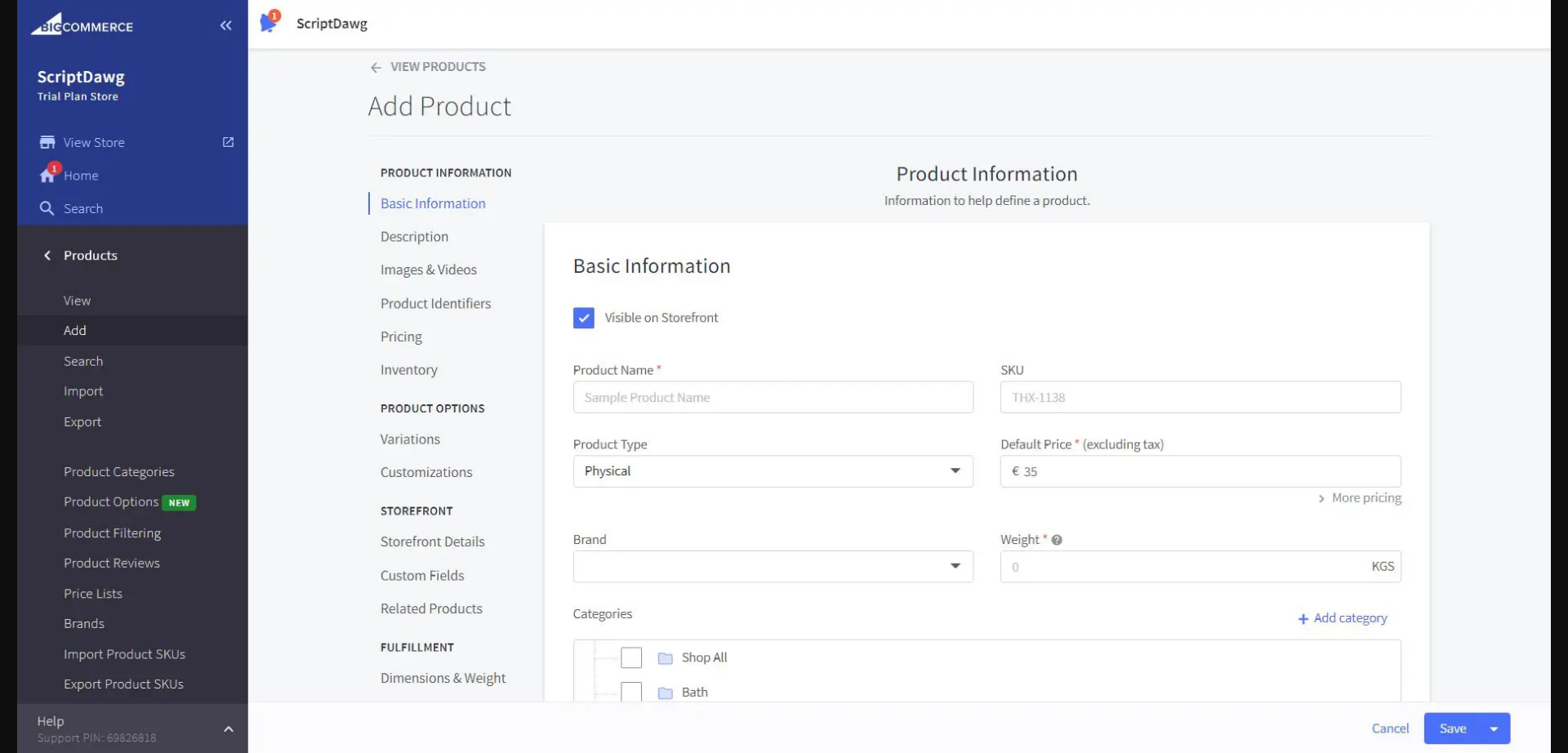Choosing between BigCommerce and Shopify is a critical decision for businesses launching or upgrading their online stores in 2025. These two platforms dominate the e-commerce space, each offering unique advantages for different types of businesses. The right choice can significantly impact a company’s growth potential, operational efficiency, and bottom line.
Comparison Overview
| Feature Category | BigCommerce | Shopify |
| Key Advantage | Extensive built-in features, ideal for complex catalogs and advanced users | Ease of use, streamlined setup, vast app ecosystem |
| Transaction Fees | No transaction fees; revenue-based plan upgrades | Transaction fees apply unless using Shopify Payments |
| Total Ownership Cost | Higher initial costs, zero transaction fees | Lower total ownership cost, especially for scaling businesses |
| SEO and Multi-Channel | Superior SEO control, multi-channel integration | Strong social commerce features, higher checkout conversion rates |
| User Interface | Steeper learning curve, 4-step setup guide | Beginner-friendly, 13-step setup checklist |
| Product Management | Up to 600 SKUs and 1,000 images per product | Up to 100 SKUs and 250 images per product |
| App Ecosystem | 1,200+ apps, less reliance on external apps | 8,000+ apps, extensive customization options |
| Checkout Process | Customizable checkout experience | Higher conversion rates, especially with Shop Pay |
| Inventory Management | Native integration with Amazon, Walmart, eBay | Multi-location inventory tracking |
| Marketing & SEO Tools | Full URL customization, advanced meta editing | Built-in integration with Semrush, standard meta-optimization |
| Email Marketing | Direct integrations with MailChimp, G Suite | Native email solution with ready-made templates |
| Social Media Integration | Native integrations with Amazon, Meta, TikTok | Strong social commerce features via Instagram, Facebook, Pinterest |
| Cart Recovery | Customizable messages, exit-intent popups | Automated recovery emails with customizable sequences |
| Pricing Plans | $29, $79, $299; 15-day free trial, 10% annual discount | $29, $79, $299; 3-day trial, $1 the first month, 25% annual discount |
| Scalability | Revenue-based plan upgrades, unlimited staff accounts | No revenue cap, caps on staff accounts, higher flexibility with app marketplace |
| Hidden Costs | Minimal with built-in features, fewer third-party app costs | Possible higher costs with app reliance, third-party integration expenses |
| Best Fit | Businesses needing built-in functionality and customization | Businesses prioritizing ease of use, rapid deployment, and scalability |
Platform Features Comparison
Both platforms offer robust e-commerce solutions, but their approaches to functionality and user experience differ significantly. A detailed analysis reveals distinct characteristics that cater to different business needs.
User Interface and Ease of Use
Shopify excels in providing an intuitive user experience with a streamlined setup process and clean interface. The platform features a 15-step setup checklist that guides merchants through store creation. BigCommerce, while powerful, presents a steeper learning curve with its four-step guide and more detailed initial setup requirements.
[su_service title=”Info” icon=”icon: info-circle” icon_color=”#000″ size=”20″ class=”InfoBox”]
Both platforms utilize section-based editors rather than drag-and-drop interfaces, allowing merchants to stack design elements systematically. However, Shopify’s interface proves more accessible for beginners, while BigCommerce’s dashboard offers deeper customization options for experienced users.[/su_service]
Built-in Functionality
BigCommerce distinguishes itself with comprehensive built-in features:
- Native blogging platform
- Advanced product options and SKU management
- Professional reporting tools across all plans
- Built-in cart-level discounts and customer group pricing
Shopify’s base platform maintains simplicity but requires additional apps for advanced features. This approach offers flexibility but may necessitate more third-party solutions for complex operations.
App Ecosystems and Integrations
The platforms present contrasting approaches to extensibility:
| Feature | Shopify | BigCommerce |
| App Store Size | 8,000+ apps | 1,200+ apps |
| Built-in Features | Fewer native features | More out-of-box functionality |
| Integration Focus | Extensive third-party options | Strong native capabilities |
BigCommerce’s architecture emphasizes built-in functionality, reducing dependency on external apps. Shopify’s vast app marketplace offers more customization options but may require additional investment in third-party solutions. Both platforms maintain strict security standards for app integration, ensuring merchant and customer data protection.

E-commerce Capabilities
E-commerce capabilities form the backbone of any online store’s operational efficiency. A detailed analysis of both platforms reveals distinct approaches to essential business functions.
Product Management
BigCommerce demonstrates superior product management capabilities with support for up to 600 SKUs per product, compared to Shopify’s 100 SKU limit. Additionally, BigCommerce allows up to 1,000 images per product, while Shopify caps at 250 images. This makes BigCommerce particularly advantageous for businesses with complex product catalogs or extensive variation requirements.
Payment Gateways
The platforms differ significantly in payment processing options:
| Feature | Shopify | BigCommerce |
| Gateway Options | 100+ | 65+ |
| Transaction Fees | 2.9% + $0.30 (Basic) |
No additional fees
|
| Built-in Solution | Shopify Payments | None |
Checkout Process
Shopify’s checkout process boasts a 12% higher conversion rate compared to BigCommerce, with features like Shop Pay increasing conversion rates by up to 50% over guest checkout. BigCommerce counters with fully customizable checkout experiences, allowing merchants to:
- Implement branded color schemes and messaging.
- Add delivery date selection calendars.
- Customize the checkout flow for specific products.
Inventory Management
Both platforms offer robust inventory management systems with these key features:
- Real-time inventory tracking across channels.
- Automated stock level adjustments.
- Low-stock alerts and notifications.
- Multi-location inventory management.

BigCommerce particularly excels with its native integration capabilities for major marketplaces like Amazon, Walmart, and eBay, allowing centralized inventory management across all sales channels through a single dashboard.
Marketing and SEO Tools
Marketing and SEO capabilities serve as crucial differentiators between e-commerce platforms, directly impacting a store’s visibility and sales potential. Both BigCommerce and Shopify offer comprehensive marketing toolsets, each with distinct advantages.
SEO Features
Both platforms provide robust SEO functionality, though their approaches differ significantly. BigCommerce offers superior URL structure control without mandatory prefixes, while Shopify includes built-in integration with Semrush’s Ecommerce Booster app for detailed optimization recommendations. Key SEO capabilities include:
| Feature | BigCommerce | Shopify |
| URL Control | Full customization | Fixed prefixes |
| Meta Editing | Advanced with Open Graph |
Standard optimization
|
| Automatic Redirects | Yes (301) | Yes (301) |
| Built-in Analytics | Comprehensive | Basic |
Email Marketing
Shopify’s native email marketing solution provides ready-made templates and comprehensive dashboard analytics. BigCommerce takes a different approach by offering seamless integration with leading platforms:
- Direct sync with MailChimp and G Suite.
- Campaign performance tracking.
- Customer segmentation capabilities.
Social Media Integration
BigCommerce demonstrates superior multichannel capabilities with native integrations for major platforms including Amazon, Meta, Walmart, eBay, Pinterest, TikTok, and Snapchat. Shopify maintains strong social commerce features through Instagram, Facebook, and Pinterest integrations, facilitating product synchronization across platforms.

Abandoned Cart Recovery
Both platforms offer sophisticated cart recovery solutions, with distinct approaches to customer re-engagement:
Shopify implements an automated recovery system featuring:
- Customizable email sequences.
- Scheduled reminder intervals.
- Performance Analytics.
BigCommerce’s abandoned cart saver allows for the following:
- Up to three automated recovery emails.
- Customizable messaging and timing.
- Exit-intent popup technology.
- Personalized incentive offerings.
[su_service title=”Important” icon=”icon: exclamation-triangle” icon_color=”#00ae27″ size=”20″ class=”ImportntBox”]
The platforms incorporate social proof elements in their recovery strategies, displaying customer reviews and testimonials to build trust during the recovery process. This comprehensive approach to cart abandonment helps merchants recapture potentially lost sales through strategic marketing automation.[/su_service]
Pricing and Value
Cost considerations play a pivotal role in selecting an e-commerce platform that aligns with business objectives and operational budgets. A thorough analysis of BigCommerce and Shopify reveals distinct approaches to pricing and value delivery.
Plan Comparison
Both platforms structure their pricing in three main tiers, with comparable monthly costs:
| Plan Level | BigCommerce | Shopify |
| Basic/Standard | $29/month | $29/month |
| Plus/Regular | $79/month | $79/month |
| Pro/Advanced | $299/month | $299/month |
BigCommerce offers a 15-day free trial, while Shopify provides a shorter 3-day trial but compensates with a compelling $1 first-month offer. Annual subscriptions earn a 10% discount with BigCommerce and a 25% discount with Shopify.
Transaction Fees
BigCommerce distinguishes itself with zero transaction fees across all plans, regardless of the payment gateway used. Shopify’s approach differs significantly:
- 2.9% + $0.30 per transaction on the Basic plan.
- Reduced rates for higher-tier plans.
- No transaction fees when using Shopify Payments.
Hidden Costs
Merchants should consider several additional expenses beyond base subscription costs:
- Staff account limitations (Shopify caps at 15 users on the Advanced plan).
- Theme customization and development costs.
- Third-party app subscriptions.
- Additional inventory location fees.
- Custom domain purchases.
Scalability
BigCommerce implements a unique revenue-based scaling model:
- Standard plan: Up to $50,000 annual revenue.
- Plus plan: Up to $180,000 annual revenue.
- Pro plan: Up to $400,000 annual revenue.
This structure forces businesses to upgrade based on success, while Shopify allows merchants to remain on their chosen plan regardless of revenue. However, Shopify’s total cost of ownership is 31% lower than BigCommerce, with implementation costs averaging 88% less and operational costs 21% lower.
For enterprises requiring extensive customization, BigCommerce provides more built-in features at lower tiers, including unlimited staff accounts and advanced shipping rate calculations. Conversely, Shopify’s ecosystem offers greater flexibility through its extensive app marketplace, though this may increase overall costs.
Final Words
BigCommerce and Shopify present distinct advantages that cater to different business needs and growth stages. BigCommerce stands out with comprehensive built-in features, unlimited staff accounts, and zero transaction fees across all plans, making it particularly suitable for businesses with complex product catalogs and specific customization requirements. Shopify excels through its user-friendly interface, extensive app marketplace, and superior checkout conversion rates while offering a lower total cost of ownership that appeals to businesses prioritizing simplicity and scalability.
The optimal platform choice depends largely on specific business requirements, technical expertise, and growth projections. Businesses seeking extensive built-in functionality and complete control over their store’s architecture will find BigCommerce’s robust feature set valuable. Companies prioritizing ease of use, rapid deployment, and access to diverse third-party integrations will benefit from Shopify’s streamlined approach and extensive ecosystem. Both platforms offer reliable solutions for building successful online stores, with the final decision resting on individual business priorities and long-term objectives.
Moiz Banoori is a Digital Marketing specialist with over eight years of experience in content creation and digital journalism. He leads teams at various brands and focuses on developing effective SEO strategies that enhance online visibility. With a degree in journalism, Moiz combines his passion for storytelling with technical skills to deliver innovative digital solutions at REDLUMB, helping clients achieve their online goals in a competitive landscape.





